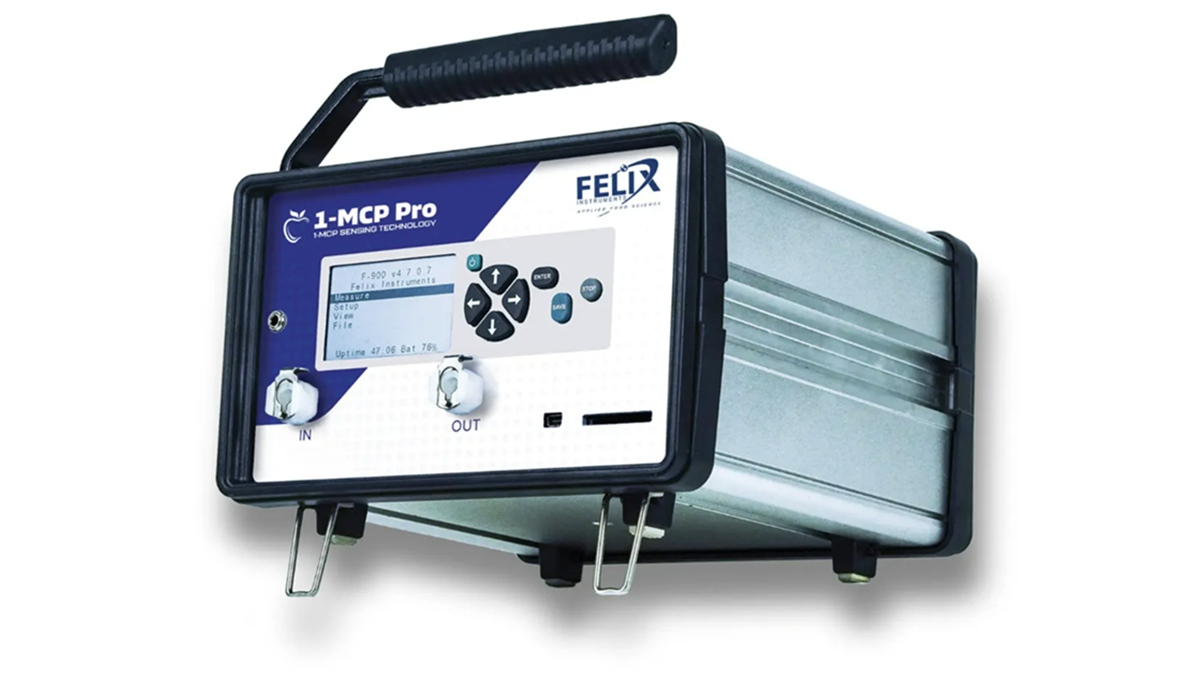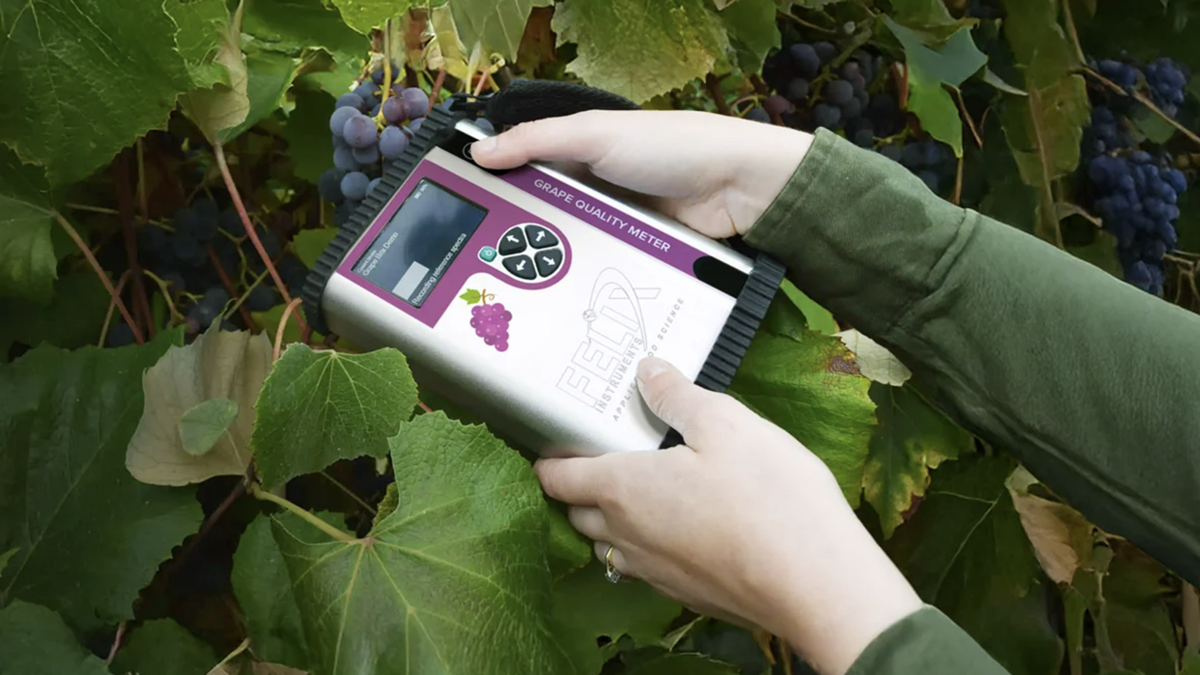Measurements
Advantages of NIR spectroscopy to determine plum quality
Spectroscopy is the technique of studying chemicals based on their interaction with light. The interaction can be absorption, reflectance, or transmission of light. The data is generated as a spectrum. Near-infrared is the range between 750-2500 nanometers (nm) and is next to visible red light. This spectrum is suitable for finding the composition of a compound, as it reacts with the C-H, O-H, and N-H bonds. Thus, NIR spectroscopy is useful in qualitative and quantitative analysis of bio compounds. Being non-destructive, NIR spectroscopy can be repeated as many times as needed on a sample without reducing yield. Modern technology has miniaturized this complex process to fit into hand-held instruments. The F-750 Produce Quality Meter, manufactured by Felix Instruments ? Applied Food Science, is NIR-based and is recommended by scientists for many fruits. It measures SSC by BRIX, titrable acidity, and color. Accurate, individual readings are given rapidly, within in 4-6 seconds. A built-in GPS makes mapping fruit trees easy. A general instrument, F-750 can be modeled for specific fruits easily, including plums. Being portable it can be used by anyone anywhere in the supply chain, from farms to retail shops, as it is user-friendly and requires no special training to operate.
10 November, 2020
Spectroscopy is the technique of studying chemicals based on their interaction with light. The interaction can be absorption, reflectance, or transmission of light. The data is generated as a spectrum. Near-infrared is the range between 750-2500 nanometers (nm) and is next to visible red light. This spectrum is suitable for finding the composition of a compound, as it reacts with the C-H, O-H, and N-H bonds. Thus, NIR spectroscopy is useful in qualitative and quantitative analysis of bio compounds. Being non-destructive, NIR spectroscopy can be repeated as many times as needed on a sample without reducing yield. Modern technology has miniaturized this complex process to fit into hand-held instruments. The F-750 Produce Quality Meter, manufactured by FELIX INSTRUMENTS, is NIR-based and is recommended by scientists for many fruits. It measures SSC by BRIX, titrable acidity, and color. Accurate, individual readings are given rapidly, within in 4-6 seconds. A built-in GPS makes mapping fruit trees easy. A general instrument, F-750 can be modeled for specific fruits easily, including plums. Being portable it can be used by anyone anywhere in the supply chain, from farms to retail shops, as it is user-friendly and requires no special training to operate. Internal parameters in plumsPlums are consumed as fresh fruits and processed to produce prunes, Damson cheese, jams, and plum brandy. The internal parameters that are of interest in controlling the quality of plum and its products are sugars, acidity, aromatic compounds like phenols, and firmness. SugarsThe fruit contains sugars such as fructose, glucose, sucrose, and sorbitol. As the fruit matures, the amount of fructose and glucose decreases and the level of sucrose increases in plums. The sugars serve the following purposes: - The fermentation of fructose, glucose, and sucrose gives ethanol used for the distillates. - Sorbitol is not useful for making alcohol, but is useful in processes where heat is used in drying or making Damson cheese. It protects the fruit from browning and changes in tastes, as it doesnt get caramelized. TastePlums have malic, tartaric, and citric acids, which are just as important as sugars for taste development. During the ripening process, the amount of acids, especially malic acid, decreases and there is a production of volatile compounds that enhance the taste of the fruits. FirmnessFruit flesh firmness decreases during maturation and ripening. Early-harvest plums are softer at maturity than late-harvest varieties. ColorInternal flesh color changes, due to ripening and other physiological reasons, have been established as an important parameter in plums. Postharvest managementNIR spectroscopy can be used to measure BRIX, titrable acidity, taste, and internal color in quality control during storage, sorting, distribution, and price-fixing. In plums that are going to be marketed as fresh fruits, SSC, titrable acidity, pH, malic acid, tartaric acid, and anthocyanin are important quality parameters. Multiculivar models have been developed for predicting SSC, total acidity, pH, and firmness of plums by NIR, and they are robust across season and location. These models can be used to monitor ripening. RipeningRipening time and post-harvest management in plums are influenced by the temperature at which they are stored. If they are cooled immediately after picking to temperatures between 0-4 ºC, they can be stored for 3-6 weeks. However, storage at lower temperatures can spoil the fruits. By monitoring ripening, management practices can be altered as necessary. By sorting plums based on their stage of ripening, they can be stored in different batches to prevent ethylene production from ripe fruits spoiling the less ripe ware. Plums are very sensitive to ethylene, so proper sorting and storage are vital. Detection of plum browningPlum flesh can turn brown as a result of storage temperatures that are too low or because the fruit is too old. Browning can also occur due to brown rot, which changes the texture, making the flesh mealy, the color changes to brown, and the flavor is lost. These changes cannot be detected externally and the fruit still looks fine, until it is eaten. NIR can successfully detect browning, so the spoiled goods can be culled to maintain the quality of the batch and fetch higher prices. Variety discrimination by tastingA favorable sugar/acid ratio is maintained to get the right flavor. In addition, NIR has been used to measure taste in plums produced not only by SSC and total acidity, but due to other volatile compounds like phenols. Based on the taste measurement, NIR can accurately sort fruits into respective varieties, even if they have the same SSC and titrable acidity. Tasting fruits non-destructively can be used to grade plums in warehouses and retailing to check for authenticity and price fixing.



.jpg)







